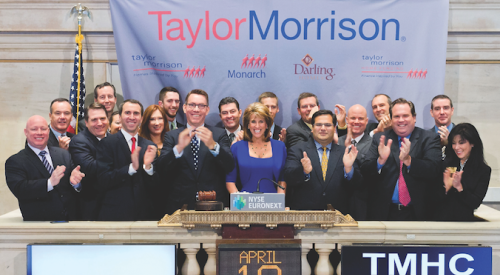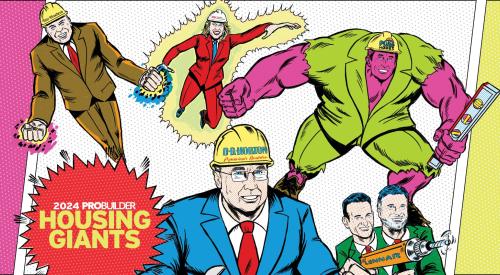|
It was probably inevitable that a housing boom that lasted 13 years would end with a cataclysmic contraction. And this is certainly one of those, a dangerous beast that will devour home building companies large and small. "It reminds me of the late '80s in Texas," says Don Horton, leader of our new No. 1 builder, Fort Worth, Texas-based D.R. Horton, "only this time, it's all across the country."
Horton regained the top of the housing industry by strategically retreating, shrinking rather than growing. After becoming the first builder to ever top 50,000 closings (in 2005), and doing it again
 |
 |
|
For the second year in a row, the U.S. housing market contracted (from nearly 2 million completions in 2006 to just 1.5 million in 2007). And the Giant 400's share of the pie, compared to non-giants, also shrank for the second straight year. Even more significant, the top two tiers of giants lost market share to smaller giants as well as non-giants. |
the next year, D.R. Horton fell to 37,717 closings in fiscal 2007 (-29.4 percent) and $9.6 billion in revenue — 34.1 percent less than the $14.5 billion it banked in 2006. Horton has cut its payroll by 60 percent since the peak of the market in 2005.
Miami-based Lennar Corp., last year's No. 1, fell farther, dropping 32.9 percent in closings to 33,283, and dropping 36.3 percent in revenues to $9.5 billion — to land at No. 2. Dallas-based Centex Corp., Bloomfield Hills, Mich.-based Pulte Homes and Los Angeles' KB Home round out the top five, the publicly held group of huge companies we used to call Supernovas. All are now losing ground at an astonishing rate. None of them look particularly super these days.
As the overall ranking shows, this downturn is hitting the largest giants hardest, and the bottom line is that non-giants are gaining market share of total U.S. housing completions for the second consecutive year. That trend is likely to continue.
We still believe it makes sense to separate the giants into groups at revenue benchmarks where watershed organizational changes often occur. For instance, at $75 million in annual revenue, we see builders begin to employ multiple layers of management and sometimes add a second geographic market. And it's certainly clear, at the other end of the size spectrum, that the Top 5 public companies are more like each other than even the mix of public and private firms just beneath them.
Still, we now cringe at the idea of calling anyone in home building a Master of the Universe, or even Rich and Famous. So this year, we're converting the groups into tiers (1 through 5) without names. Tier 2 includes all the giants below the top five, but above the $1 billion revenue line. Tier 3 kicks in at $200 million in revenue, and Tier 4 at $75 million. Tier 5, the smallest giants, comprises giants with less than $75 million in revenue.
A year ago, we were amazed at how a housing market downturn reshuffled the Giant 400, noting that 154 builders dropped five positions or more, and 137 rose by at least five slots. Of course,
 |
|
While U.S. Commerence Department Data shows rental housing completions dropped in 2007, the Giant 400 recorded gains in both rental and unit production (5.5 percent) and rental revenues (15.8 percent) over the previous year's Giant 400. Rental builders are climbing the rankings. |
we had no idea then that this year's rankings would make that volatility pale in comparison. This year, 108 builders rose by 20 or more positions, and 86 dropped a similar distance.
Of course, you didn't need to go up in closings or revenue to rise in the rankings. "I'll be damned!" exclaimed Chicago builder Buz Hoffman of Lakewood Homes when he learned he'd moved up 22 positions to No. 129 even though Lakewood closed 244 fewer houses in 2007 than the year before and revenues dropped from $189 million to $155.6 million.
"The Chicago market's down about 50 percent in the last year," he says. "We're shrinking. If we did anything else, we'd just be fooling ourselves and our financial partners. We've already dropped from 212 employees to 60. If things get any worse, I'll have to drop another 'z' out of my name!"
Last year, the theme of our coverage of the Giant 400 was the "selective" nature of the housing downturn — that Texas and the Carolinas were untouched in 2006, which allowed builders in those states to climb the rankings at the expense of many in California and Florida. This year, it's obvious that Texas and the Carolinas have not escaped the downturn, but builders there are still relatively better off. And we can also see that rental housing is beginning to act counter-cyclically to for-sale housing. Run your finger down the rankings poster in search of firms with big position increases. You'll find most are either rental housing specialists or Texans.
Giant builders who operate only in Texas dropped an average of 7.3 percent in revenues in 2007, but Texas-based giants that also operate in other states declined more — an average of 23.9 percent. And non-Texas giants declined 29 percent on average. The trend is that most Texas builders are in decline, but not nearly as much as builders in other states.
Frisco, Texas-based Darling Homes is an example. Operating in the high-end of Dallas and Houston move-up markets with an average price above $400,000, Darling's closings dropped from 709 in 2006 to 599 in 2007, and revenues declined from $264 million to $242 million. Yet Darling rose 21 positions and cracked the top 100 at No. 84.
"Unit-wise, we'll be closer to 525 this year," says Bill Darling. "Texas is not all fun and games, but
 |
|
Giant 400 production builders hit the top of the Roaring 2000s rollercoaster in 2006 (based on revenues from 2005 closings). The 2008 giants' closings plunge in 2007. |
it should come back faster than other markets. We never had the big price spikes, and our local economies are doing well. We've got a lot of job creation."
And here's the shocker: some Texas builders are growing — a few of them by a lot. Examples include Austin entry-level specialist Main Street Ltd., which climbed 53 places (from 205 to 152) on the strength of unit growth from 991 to 1,008, with revenues up from $126 million in 2006 to $133.1 million in 2007. And Peter Shaddock's Sotherby Homes rose 71 spots (192 to 121) as Dallas closings went from 306 to 383 and revenues from $132.3 million to $163.6 million.
Ed Horne's Austin-based move-up firm, Wilshire Homes, jumped 39 spots (147 to 108) as units dropped from 712 to 634, but revenues climbed from $192 million to $197.9 million. And Houston-based on-your-lot specialist Tilson Homes recorded a staggering 101-slot move (284 to 183) as closings jumped from 540 to 633 and revenues went from $82 million to $107.9 million. "Our business model makes a lot sense when the market cycles down," says marketing director F. Gary Lewis. "We don't own land.
"The price of gas is hurting us because our supers drive a ton of miles," says Lewis, "but it's not cutting into our market. Our segment just doesn't want to live in town. It's a cultural thing in a pioneering state. If a Target store opens within 10 miles, they move out another 20."
But perhaps the most amazing move of all was the 196-slot jump of Arlington, Texas-based Wall Homes. This move-up specialist went from No. 367 to No. 171 in its third year of operations, as closings jumped from 258 in 2006 to 558 last year. Revenues shot up from $44.2 million to $118 million. More than 100 of those added closings came as a result of Wall's purchase of Technical Olympic USA's Dallas division. President Steve Wall promises more growth. "Our target this year is 1,000 closings," he says, then adds that the increase will come with a higher average sale price.
So what's the bottom line for builders not currently drinking Lone Star? If you don't want to buy a Stetson and move, look no farther than South Florida for a hero who proves you can sell houses, build them, and even make money in this market. Craig Perry of Coral Springs, Fla.-based
 |
 |
| While housing is down everywhere, Texas markets are still better than most. As a result, Texas builders are climbing Giant 400 rankings, some more than 100 positions. | Texas Giants' closings are not dropping as far or as fast as those of builders in other states because Texas' oil-based economy is vinbrant and house prices are stable. |
Centerline Homes rose 52 spots this year — from No. 148 to No. 96 — cracking the Top 100 with $212 million in revenue (up from $191.3 million), even though his unit volume dropped from 535 to 503.
Many production builders in Florida would love to sell 50 houses, let alone 500. "We're selling houses every day," Perry says. "Our biggest problem right now is that we can't get our community count up because we stopped buying land in 2005. Our closings and revenues will be down in 2008 because we only have nine active communities. Last year, we had 12."
When land prices spiraled up in 2005, Perry had the discipline to walk away. "We just knew there was too much product at too high a price," he says. "We don't have a magic formula. We just stick to the basics we all know. But sometimes it's tough to keep from getting caught up in the exuberance of a hot market."
Perry didn't make a pile of money then. He stuck to making a fair profit on houses sold at a fair price. Somebody must have noticed, because people are still buying Centerline's houses. And Perry doesn't have financing problems either. His two lenders just extended his credit lines through 2010. Maybe that's because his income statement still shows an 8 percent profit.
But wait! There's more Giant 400 Analysis up ahead:
- Land, Impairments Dog Public Home Builders
- Rental Apartments Poised for Liftoff
- Sun Cuts Clouds Over Manufactured Housing
- Where Are We Heading?
- View the 2008 Giant 400 List
|












